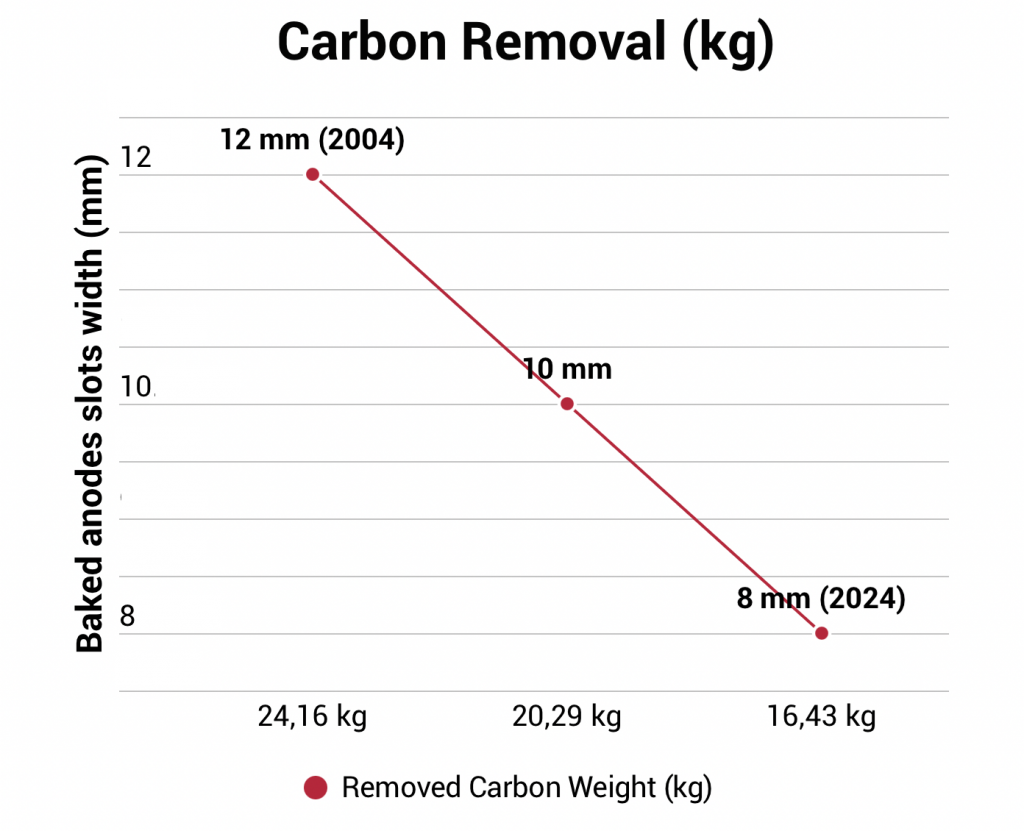Technological progress related to the production of anode-cutting machines is continuously developing and transforming to support the new energy and environmental challenges that the aluminium industry has been facing in recent years.
Cutting slots in the anodes allow the gas produced during the electrolysis process to escape, thus improving the energy efficiency in the primary aluminium production, which directly benefits the carbon footprint of the process. Where anodes are slotted, the productivity of smelters is also improved, and pot management experiences much better conditions since pot noise is almost eliminated, achieving extremely high pot stability. Slots are made to create a channel, which is an easy and constantly open way for gas to escape from the lower surface of the anodes, thus eliminating gas bubbles accumulation, which, when released through the bath, results in an unstable and variable ohmic profile of the pots. Consequent elimination of the anode effects also improves the work environment and the operators’ safety in the pot rooms.
Automatic Anode Slots Cutting Machines (ASCM), manufactured by T.T. Tomorrow Technology, cut slots in baked anodes in automatic mode at a depth up to 450 mm and may be as thick as 12, 10 and 8 mm, with variable shapes. Slots geometry is extremely flexible, and operators may easily modify slots dimensions and profiles via the friendly HMI system of the machine control system. Fig. 1 also shows combinations of possible slot profiles, while specific values of slots dimensions can be selected by operators.
Since 2003, after the delivery of its first anodes cutting system, T.T. Tomorrow Technology has always kept its research activity aimed at improving the efficiency of its anodes slot cutting machines on the baked anodes as well as implementing their efficiency and operational performance.
An important step in addition to the technological evolution that has taken place in the last twenty years in the ASCM concerns the way in which the cutting blades rotate towards the advancement system of the baked anodes in the slot formation process.
In the newest ASCM models, we have implemented climb-cutting technology and definitively abandoned the conventional mode.
With the implementation of this most modern cutting solution, it is now possible to reach a production rate of up to 60 anodes/hours and more. At the same time, we can keep the capability of making any thinkable slot shape in different geometries, such as straight, inclined and interrupted.
The technological evolution of ASCM has gone through the following phases in the last 20 years.
In the latest decade we have been testing various types of blades before stabilizing and placing on the market the state-of-the-art 6-mm blades which are able to create 8-mm slots on anodes having depth up to 450 mm.
The main challenge has been to check the blades’ stability and total avoidance of vibrations. Nonetheless, we have been able to reach a productivity of 60 anodes/hours.
So far, we have been slotting several millions of anodes with 6-mm blades, which proves that the system is perfectly stable and can generate a remarkable productivity advantage with carbon savings of up to 32% compared with traditional slots made with 10-mm blades (see Table 2).
We present below the business case of one of our customers, who has used 10-mm blades for some years before gradually switching to 8-mm blades first and then to 6-mm blades.
Table 3
Table 4
An important contribution to this substantial evolution of the Anode Slots Cutting Machine has been provided by the implementation of the automatic control system of the blades’ cutters’ wear state. This automatic vision system of every single cutter, with the aid of the AI, allows to monitor constantly the working conditions of the blades and provides information in real-time about their wear state.
This vision system is being implemented on some of the machines which are currently in operation with the aim of further improving the operational performance of our systems.
To conclude:
The progressive switch from the 10-mm blades to either the 8-mm or the 6-mm blades has proven to have a positive effect on both the production costs and the environmental impact of aluminium production.
The possibility of using thinner blades and monitoring in real-time both their performance and their state of wear through the AI has made this investment not only cost-effective but also necessary. Our analysis of operational Anode Slot Cutting Systems has proven that the adoption of thinner blades and AI vision equipment can yield a Return on Investment (ROI) within a period of 12 to 18 months.






